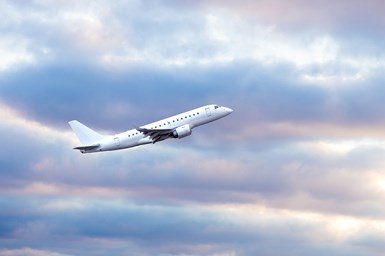Companies Sign Letter of Intent to Provide Certified 3D Printed Cabin Solutions
Materialise, Proponent and Stirling Dynamics aim to support the aerospace aftermarket with the design, production and distribution of certified 3D printed cabin solutions.
Materialise has signed a letter of intent (LOI) with Proponent, an independent aerospace distributor, and Stirling Dynamics, an EASA 21.J-certified aerospace design organization, to provide certified cabin solutions for aircraft.
Stirling Dynamics, an Expleo company, is strengthening an existing partnership between Materialise and Proponent that was formed in 2021. By combining forces, the three companies can support the aerospace aftermarket with the design, production and distribution of certified 3D printed cabin solutions.
As an aerospace-approved Design Organization (DOA), Stirling Dynamics develops improved, certified designs for 3D printed interior cabin parts and provides complete aircraft documentation and installation instructions.
By adding an EASA Part 21.J DOA to the partnership, the companies create a unique collaboration — bringing together the ability to identify additive manufacturing (AM) applications and design them by a certified DOA, with certified production by Materialise as a 21.G POA and then distribution through Proponent as a large independent distributor. This will serve to further lower hurdles for OEMs and aircraft operators in the integration of such solutions.
“We are really excited to be partnering with Materialise and Proponent to collectively bring the aviation market a true end-to-end service for aircraft modification and repairs,” says Bandula Pathinayake, vice president of Stirling Dynamics. “As an EASA-approved Part 21.J Design Organization, we are passionate about innovation, and we look forward to applying our extensive design capabilities to meet the unique challenges of aviation customers.”
Together, Materialise, Proponent and Stirling Dynamics aim to accelerate the adoption of 3D printing for cabin parts. Through the identification and design of smart 3D printed solutions for OEMs, airlines and MROs, this partnership seeks to give airline customers the possibility to easily leverage the unique manufacturing benefits 3D printing offers.
“By combining our respective expertise, we are creating a powerful alliance with the skills needed to lower AM adoption barriers in the aeronautics industry,” says Jurgen Laudus, vice president of Materialise Manufacturing. “We present the opportunity to design, produce and distribute certified 3D-printed solutions, supporting the aerospace aftermarket in leveraging the exceptional benefits of 3D printing.”
Already, several cabin repair solutions have been successfully developed by Stirling Dynamics and Materialise, solving specific issues the customers face in their cabins. Proponents can leverage their OEM relationships to develop OEM-endorsed and certified solutions, making them available to operators worldwide that face similar issues.
“With Stirling Dynamics joining our partnership, we can offer our OEM partners qualified solutions that can easily be incorporated into their aftermarket supply chain,” says Erik Krol, Proponent vice president of strategic business units. “Through this partnership, OEMs can deliver spare parts and repairs in an extremely cost-effective way, ultimately benefiting the airlines and MROs.”
The partners say the potential of 3D printing to revolutionize the aeronautics industry is significant. This digital manufacturing technology enables design optimizations, functional improvements and the creation of lighter and stronger parts that were previously unachievable with conventional manufacturing techniques. In addition to these advantages, 3D printing offers remarkable time and cost reductions, further enhancing its appeal for aerospace applications.
Materialise has a history of partnering to propel AM in aviation, including earlier collaborations with GKN Aerospace and the aforementioned Proponent.
Related Content
3D Printed Titanium Replaces Aluminum for Unmanned Aircraft Wing Splice: The Cool Parts Show #72
Rapid Plasma Deposition produces the near-net-shape preform for a newly designed wing splice for remotely piloted aircraft from General Atomics. The Cool Parts Show visits Norsk Titanium, where this part is made.
Read More3D Printed Lattice for Mars Sample Return Crash Landing: The Cool Parts Show Bonus
NASA Jet Propulsion Laboratory employs laser powder bed fusion additive manufacturing plus chemical etching to create strong, lightweight lattice structures optimized to protect rock samples from Mars during their violent arrival on earth.
Read MoreBeehive Industries Is Going Big on Small-Scale Engines Made Through Additive Manufacturing
Backed by decades of experience in both aviation and additive, the company is now laser-focused on a single goal: developing, proving and scaling production of engines providing 5,000 lbs of thrust or less.
Read MoreTwo 12-Laser AM Machines at Collins Aerospace: Here Is How They Are Being Used
With this additive manufacturing capacity, one room of the Collins Iowa facility performs the work previously requiring a supply chain. Production yield will nearly double, and lead times will be more than 80% shorter.
Read MoreRead Next
Postprocessing Steps and Costs for Metal 3D Printing
When your metal part is done 3D printing, you just pull it out of the machine and start using it, right? Not exactly.
Read MoreBike Manufacturer Uses Additive Manufacturing to Create Lighter, More Complex, Customized Parts
Titanium bike frame manufacturer Hanglun Technology mixes precision casting with 3D printing to create bikes that offer increased speed and reduced turbulence during long-distance rides, offering a smoother, faster and more efficient cycling experience.
Read MoreCrushable Lattices: The Lightweight Structures That Will Protect an Interplanetary Payload
NASA uses laser powder bed fusion plus chemical etching to create the lattice forms engineered to keep Mars rocks safe during a crash landing on Earth.
Read More





















